Back to Journals » Patient Preference and Adherence » Volume 13
What is the most important factor affecting patient satisfaction – a study based on gamma coefficient
Received 4 December 2018
Accepted for publication 22 February 2019
Published 10 April 2019 Volume 2019:13 Pages 515—525
DOI https://doi.org/10.2147/PPA.S197015
Checked for plagiarism Yes
Review by Single anonymous peer review
Peer reviewer comments 2
Editor who approved publication: Dr Naifeng Liu
Jinming Fang,1,2 Ling Liu,2 Pengqian Fang1
1School of Medicine and Health Management, Tongji Medical College, Huazhong University of Science and Technology, Wuhan 430030, People’s Republic of China; 2Wuhan Forth Hospital, Puai Hospital, Tongji Medical College, Huazhong University of Science and Technology, Wuhan, 430033, People’s Republic of China
Objective: To analyze the influencing factors of patients satisfaction and find out the key factors, so as to provide suggestions for improving health policy.
Methods: A questionnaire survey was conducted in Wuhan China. A total of 2,719 questionnaires were collected and 2,626 valid answer sheets were obtained. Through statistical description, chi-square test. Gamma coefficient analysis and binary logistic regression, the key factors affecting patient satisfaction were obtained.
Results: It was found that the “Medical staff’s service attitude” was the most important factor affecting patient satisfaction, followed by “Medical staff services technology” and “Hospital convenience”. The demographic characteristics of patients had no significant effect on satisfaction, and “Medical services utilization” of patients had a certain impact on satisfaction. Patients had a higher degree of satisfaction with the “Hospital convenience”, “Hospital facilities and environment”, “Medical staff services technology”, “Medical staff service attitude”, but had a lower degree of satisfaction with “Medical expense” and “Reimbursement ratio for medical expenses”.
Conclusion: “Medical staff’s service attitude”, “Medical staff services technology” and “Hospital convenience” was the most three important factors. The health managers should focus on the above three aspects and implement appropriate management decisions to improve patient satisfaction.
Keywords: patient satisfaction, urban, hospitals, health care reform, public policy
Introduction
Medical and health services were public utilities to promote people’s health. Patients were the objects of medical and health services. The fundamental goal of the government in developing health services was to meet the growing health needs of the people. Patient satisfaction, which referred to the conclusion reached by patients and their families after comparing their feelings during the medical service with their previous expectations, was the criterion of medical service quality.
Patient satisfaction was usually measured by a patient’s questionnaire and was critical in assessing the quality of medical care.1 In today’s highly competitive medical environment, satisfaction had become the core competitiveness of medical and health institutions.2,3 Therefore, it was very important for medical institutions and their superior departments to find out the factors that affect patients’ satisfaction with medical services.
Some countries tried to improve medical satisfaction through health care reform. The Netherlands had gradually introduced a competition mechanism in the field of health care through a series of administrative reforms, so as to improve the efficiency of the reform in the field of health care and medical satisfaction. Britain implemented the patient-centered concept and introduced a competition mechanism in the general practitioner, to increase the patient’s right of choice.4,5 The Obama administration took medical insurance as the breakthrough point in the reform, which to strengthen the government role, trying to keep the doctor from the medical insurance, medical authorization and medical lawsuit of trivial matters, in order to improve the satisfaction on both patients and medical staff.6,7
In 2009, China launched a new round of medical and health system reform.8–10 Its short-term goals included five areas: accelerating the establishment of the basic medical security system, implementing the national essential drug system, improving the primary health care service system, promoting the equalization of basic public health services, and initiating the pilot reform of public hospitals.8,11,12 Among them, the pilot reform of public hospitals included the following contents: establishing the management system of public hospitals, establishing new operating mechanism of public hospitals, especially compensation mechanism, reducing the price of drug consumables, establishing the division of labor and cooperation between different levels of medical institutions, carrying out graded diagnosis and treatment and two-way referral.13 The purpose was to reduce the medical economic burden of residents, increase the income of the medical staff, reduce the risk of the medical security system, and provide safe, effective, convenient and cheap health services for the whole people, in order to improve the patient satisfaction.
Previous studies had shown that there were many factors influencing patient satisfaction, Some researchers found that, among demographic characteristics, age, health status, and race consistently had a statistically significant effect on satisfaction scores. Among the institutional characteristics, hospital size consistently had a significant effect on patient satisfaction scores.14 Some studies suggested that patients with better health tend to be more satisfied with their medical care, but the cause and effect of this relationship had not been determined.15 Some researchers believed that age and illness are important factors affecting patient satisfaction, and elderly patients tended to be satisfied with the medical process, while severe patients tended to be dissatisfied with the medical process.16,17 Other studies had found that hospital environment, service attitude of hospital staff and other basic services, such as catering, can affect patient satisfaction.18
Through literature review, it could be found that the factors affecting patient satisfaction mainly come from two aspects. One was the individual factors of patients, including gender, income, health status, medical insurance, marital status, family size, etc. The second was the factors from the hospital, including medical conditions, fees, institutional level, environmental facilities.19–24
However, the results of different research were not consistent, and there were few studies on the importance of factors affecting patient satisfaction. This study was based on the background of China’s medical and health reform. Try to explore the key factors affecting patient satisfaction and provide some suggestions for the reform.
Methods
Study populations
We chose to investigate in the Wuhan city in China. Wuhan was the capital of Hubei Province and was located in central China. Wuhan was rich in medical resources and its economic development was at a medium level in China. There were many medical institutions of various affiliations and levels. Wuhan City initiated the reform of the medical and health system at the end of 2015. In 2017, all public hospitals in Wuhan were carried out reform. The reform of public hospitals in Wuhan was relatively mature and stable, which could accurately reflect the effect of China’s medical reform policies. We believed this survey was representative of China’s public hospital reform.
We stratified hospitals according to their affiliation and adopt the method of stratified sampling. The stratum of hospitals included: Hospital administered by the National Health Commission, Provincial Hospital, Municipal hospital, District hospital, Military hospital, and Enterprise-owned hospital. The purpose was used to make the sample more representative. Finally, thirteen hospitals were selected, and the hospital level included Secondary hospital and Tertiary hospital, and the category included General Hospital. Specialized Hospital, Hospital of Chinese Medicine, and Maternal and Child Health Hospital.
At least 200 patients were investigated in each hospital. For outpatients, a convenient sampling method was used to investigate the patients who had been treated. For inpatients, the inpatient departments of the hospital were randomly sampled first, and then all patients with more than 3 days of hospitalization in the department were investigated. A total of 2,860 questionnaires were distributed and 2,719 were returned.After removing incomplete and illogical questionnaires, 2,626 valid answers were finally obtained. This study was approved by the Ethics Committee of Puai hospital (No: KY 2018-027-01). The privacy was strictly protected by filling in the questionnaires anonymously.
Questionnaires
From previous studies, we selected possible influencing factors and put them in our questionnaire. The questionnaire consisted of three parts. The first part collected the basic Socio-demographic characteristics of patients, including “Gender”, “Age”, “Place of residence” and “Type of medical insurance”. The second part was medical services utilization of patients including “Hospital affiliation”, “Hospital level”, “Hospital category”, “Treatment type”, “Reason for medical”, “Whether this hospital is the preferred medical institution”, and “Registration method”. The third part was patients’ overall satisfaction and factors related to patient satisfaction, such as “Hospital convenience”, “Hospital facilities and environment”, Medical staff services technology, “Medical staff service attitude”, “Medical expenses”, “Reimbursement ratio for medical expenses”. Considering the cultural level and cognitive ability of the patients, the questions about satisfaction adopted the Likert’s three-point method, that was, one point meant very dissatisfied (which meant very bad, very inconvenient, and very expensive), three points meant moderate (which meant not too bad), and five points meant very satisfied (which meant very good, very convenient, and very cheap).
Index of measurement
The Gamma coefficient was considered to be a good indicator for the correlation analysis of ordered classification data. Its value was between −1 and 1. When G=0, it meant the two variables were irrelevant. When G>0, the two variables were positively correlated, and G<0 meant negatively correlated. The closer the absolute value of G was to 1, the greater the degree of association was, the closer its’ value was to 0, and the smaller the correlation degree was.
Statistical analyses
Excel 2016 was used for the preparation of a database, and a double check method was used to enter the data. SPSS 24.0 was used for statistical analysis. First, a preliminary analysis of the overall data was performed using statistical descriptions. Second, the chi-square test was used to screen the influencing factors of satisfaction. Third, the Gamma coefficient was used to analyze the correlation between patients’ overall satisfaction and factors related to patient satisfaction. Fourth, Multiple analysis was utilized to explore deeper relationships.
We took patient satisfaction as the dependent variable, encoding “very satisfied” as ‘1ʹ, “Moderate” and “very dissatisfied” as ‘0ʹ, and then used binary logistic regression to determine the significant factors influencing patient satisfaction. A linear regression model was used first to determine whether there was multicollinearity between independent variables. After that, the variables were placed in binary logistic regression and the variable selection method was using the forward LR. Socio-demographic characteristics and medical services utilization of patients were included in the equation in the form of dummy variables, and factors related to patient satisfaction were included in the equation in the form of ordered variables. the type I error rate was set to 0.05. Odds ratios(OR)were recorded with 95% confidence interval.
Results
Statistical description
Descriptive statistics were performed on the patients’ basic characteristics and Table 1 was obtained. The patients investigated were mainly comprised of female (53.8%). The majority of the patients were under the age of 35 years old (38.6%). Most of the patients lived in Wuhan (71.4%), and 83.0% of the patients had social medical insurance. According to the patient’s medical services utilization, the municipal hospitals (30.8%), tertiary hospitals (92.4%), and general hospitals (77.2%)were the main hospitals. and the main reason for medical was to be sick (87.2%). The hospital Surveyed in was the patients’ preferred medical institution accounted for the majority(88.2%), and the Registration method was mainly concentrated in hospital registration (80.2%). The information was shown in Table 2. The percent of patients’ overall satisfaction was 85.5%, The percent of satisfaction on the “Hospital convenience”, “Hospital facilities and environment”, “Medical staff services technology”, “Medical staff service attitude”, “Medical expenses”, and “Reimbursement ratio for medical expenses” was 72.0%, 75.0%, 83.8%, 84.5%, 15.6%, 45.6%respectively (Table 3).
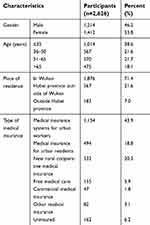 | Table 1 Socio-demographic characteristics of patients |
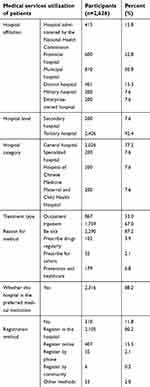 | Table 2 Medical services utilization of patients |
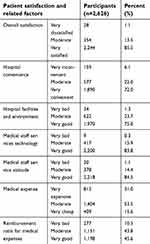 | Table 3 Patients’ overall satisfaction and factors related to patient satisfaction |
Univariateanalyses
Taking the overall satisfaction as the indicator variable and the Socio-demographic characteristics and medical services utilization of patients as the grouping factors, the chi-square test was performed, and Table 4 was obtained. There was no statistically significant difference in “Gender”, “Place of Residence”, “Hospital level”, and “Reason for medical” (p>0.05), the other factors exhibited significant differences (p<0.05).
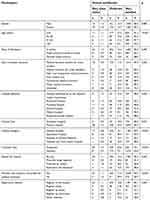 | Table 4 Univariate analysis of patient satisfaction |
In the Gamma test, all factors related to patient satisfaction had a positive correlation with overall satisfaction(Table 5) and were statistically significant (p<0.001),The three most relevant factors were “Medical staff service attitude”(Gamma=0.87), “Medical staff services technology” (Gamma=0.85) and “Hospital convenience” (Gamma=0.77). All the statistically significant factors would be analyzed in the Multivariate analysis.
 | Table 5 Correlation analysis of patients’ overall satisfaction and factors related to patient satisfaction |
Multivariate analyses
Prior to binary logistic regression, a linear regression model was used to test for the existence of multicollinearity between independent variables. The result showed that all independent tolerance value of was greater than 0.1 and VIF value was not great than 5 (which could see in supplementary materials), that was to say, all the independent variables did not have multicollinearity, then we could place all variables into the binary logistic regression directly. After 6 iterations, 10 variables entered the equation. The Variables were “Hospital affiliation”, “Hospital category”, “Treatment type”, “Whether this hospital is the preferred medical institution”, and all factors related to patient satisfaction (p<0.05; Table 6). The Omnibus Tests of Model Coefficients showed the chi-square value was 914.993 (p<0.001), which meant the model is statistically significant. The Hosmer and Lemeshow Test showed the chi-square value was 15.518 (p=0.050), which meant that the information in the current data had been fully extracted and the goodness-of-fit of the model was enough. This model could correctly predict 90.7% of the study subjects, with the sensitivity of 97.3%.
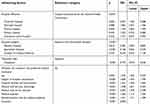 | Table 6 Multiple analysis of the factors influencing patient satisfaction |
In particular, compared with the “Hospital administered by the National Health Commission”, the odds of patient satisfaction in the “Provincial Hospital”, “Municipal hospital”, “District hospital”, “Military hospital”, and “Enterprise-owned hospital” was higher (the OR was 2.697, 1.004, 1.144, 1.523, 1.517 respectively). Compared with the “Maternal and Child Health Hospital”, the odds of patient satisfaction in “General Hospital”, “Specialized Hospital”, and “Hospital of Chinese Medicine” was lower (the OR was 0.405, 0.106, 0.516 respectively). Compared with “inpatients”, the “Outpatients” were less likely to feel satisfied (OR=0.475, p<0.001). Compared with “non-preferred hospitals”, the patients were more likely to feel satisfied with the “preferred medical institution” (OR=1.755. p=0.003.)
With the improvement of “Hospital convenience” for each grade, the patients’ overall satisfaction odds would increase by 60.9% (OR=1.609, p<0.001). With the improvement of “Hospital facilities and environment” for each grade, the patients’ overall satisfaction odds would increase by 45.1% (OR=1.451, p<0.001). With the improvement of “Medical staff services technology” for each grade, the patients’ overall satisfaction odds would increase by 93.8% (OR=1.938, p<0.001). With the improvement of “Medical staff service attitude” for each grade, the patients’ overall satisfaction odds would increase by 103.0% (OR=2.030, p<0.001). With the improvement of “Medical expense” for Each grade, the patients’ overall satisfaction odds would increase by 26.9% (OR=1.269, p<0.001). With the improvement of “Reimbursement ratio for medical expenses” for each grade, the patients’ overall satisfaction odds would increase by 24.1% (OR=1.241, p<0.001).
Discussion
The theory of customer satisfaction originated from enterprise management. Most scholars’ understanding of customer satisfaction revolves around the “expectation-difference” paradigm. The basic connotation of this paradigm was that customer expectation forms a reference point for product and service comparison and judgment. Customer satisfaction was perceived as a subjective feeling, which described the degree to which customers expect to be satisfied with the purchase of a particular commodity. Customer satisfaction was at the heart of modern marketing theory and practice. Hospitals, like enterprises, were able to survive by meeting consumer needs.25 In modern hospital management, patient satisfaction was also the embodiment of hospital comprehensive strength. There were many factors influencing patient satisfaction, and through this study, we identified the key factors that affect patient satisfaction.
“Medical staff service attitude”, “medical staff services technology”, and “hospital convenience” were the three most important factors affecting patient satisfaction
Previous studies had revealed that Chinese patients were more concerned about doctors’ attitudes toward services, medical quality and rationality of medical costs. Dissatisfaction among Chinese patients had focused on high costs (including expensive drugs, high testing costs, expensive medical devices, and over-treatment), long waiting times (including long queues and many medical links) and unreasonable processes (such as paying first and then seeing a doctor),26 Some experts had shown that interpersonal skills, the humanitarian quality of the staff,a good doctor-patient relationship,information provided to the patient about his or her condition are crucial,1,27,28 There were also studies believed that doctors’ professional knowledge was one of the main factors that affect patient satisfaction,29and many patients were highly dissatisfied with hospital facilities.
In our research, “Hospital convenience”, “Hospital facilities and environment”, “Medical staff services technology”, “Medical staff service attitude”, “Medical expense”, “Reimbursement ratio for medical expenses” were all influential factors with statistical significance. this was roughly the same as the previous study, but our research had taken a further step. We ranked these factors, among which, the strongest influencing factor was “Medical staff service attitude”, followed by “Medical staff services technology” and “Hospital convenience”. This indicated that most patients were more concerned about whether their condition was cared about and respected by doctors. It also showed that being patient-centered was more important than being disease-centered. The weakest influencing factor was “Reimbursement ratio for medical expenses”, that meant, although the “Reimbursement ratio for medical expenses” had statistical significance on patient satisfaction, it was not a strong influence factor. It could only be considered as a secondary factor in improving patient satisfaction.
For the health care reform department and hospital administrators, it was very difficult to improve all aspects of patient satisfaction, so it was especially important to grasp the most important factors affecting patient satisfaction. Our results showed that if hospitals wanted to quickly improve patient satisfaction, they should focus on improving service attitudes.
The demographic characteristics of patients had no significant effect on satisfaction, and the medical services utilization of patients had a certain impact on satisfaction
Some studies had shown that older patients, patients with low education levels, married patients and patients with high social status have higher satisfaction.30 Some studies believed that the patient’s personal characteristics were the decisive factor of satisfaction,31 in addition, some studies had shown that men tended to have higher satisfaction scores than women.32 Conversely, others believed that patients’ demographic variables were not associated with patient satisfaction,33,34 In this study, after adjusting confounding factors by multivariate regression analysis, we found that “Gender”, “Age”, “Place of Residence”, “Type of medical insurance” had no significant effect on satisfaction.
We also found that the medical services utilization of patients had a certain impact on satisfaction. The hospitals’ affiliation determined the medical resources it received and the comprehensive medical capacity.35 This might affect the patient’s feeling. The satisfaction of inpatients was higher than that of outpatients, which was consistent with previous research.26,36 Perhaps the inpatients had more contact with the medical staff and had a better understanding of the hospital’s complicated service processes, so they could be more considerate of the hard work of the medical staff. However, outpatients often experienced complicated procedures and needed to wait a long time to get a shorter treatment service,26 which could cause dissatisfaction. It was suggested that the hospital should strengthen outpatient management, optimize the diagnosis and treatment process, shorten the waiting time of patients. Patients were more satisfied with the preferred hospital, which might be due to their approval of the preferred hospital. In China, the hierarchical medical system was not yet established, and patients were not restricted by medical insurance, they could choose any hospital for diagnosis at will. Therefore, the assessment would be more naturally satisfied when the patient chose a hospital that was familiar and trusted. When patients came to a non-preferred hospital, they were unfamiliar with everything, so it was easy to bring about communication problems and caused dissatisfaction. It was suggested that hospital managers should pay more attention to referral patients from other hospitals, strengthen the introduction of the basic hospital information, make patients more familiar with the hospital environment and medical service process, and make full communication for the treatment and prognosis of the disease, so the patients would feel more comfortable and satisfied.
Other relevant information obtained from the statistical analysis
From descriptive statistics, patient satisfaction rate with the “Hospital convenience”, “Hospital facilities and environment”, “Medical staff services technology” and “Medical staff service attitude” were much higher than “Medical expense” and “Reimbursement ratio for medical expenses”, indicating that further efforts were needed to control the cost of patients and increase the reimbursement ratio of medical insurance . Patients with social medical insurance accounted for the majority, the proportion of uninsured patients was very small, indicating that China’s health insurance coverage was quite good. The relatively low proportion of commercial insurance indicated that the commercial insurance market had not yet fully developed. The main reason for medical treatment was “Be sick”, indicating that the concept of medical treatment was still the mainstream, and the concept of health prevention still needed to be popularized. Although various channels such as online booking and telephone booking had been used in each hospital, the utilization rate of them was not high. The vast majority of patients still chose to register in the hospital. These issues must be taken seriously by the health care reform department.
Limitation
This study was a cross-sectional study. It could only obtain the views of patients at that time, and could not compare the situation before and after. The categories of some influencing factors in this study were not detailed enough, which will be further improved in subsequent studies.
Conclusion
We found that the three factors most associated with patient satisfaction were “Medical staff service attitude”, “Medical staff services technology”, and “Hospital convenience”. The demographic characteristics of patients had no significant effect on satisfaction, and medical services utilization of patients had a certain effect on satisfaction. The medical reform department should make policy adjustment accordingly to promote the reform development.
Ethics approval
The study was reviewed and approved by the Ethics Committee of Puai hospital, Wuhan, China (No: KY 2018-027-01). The survey documentation included printed instructions and information for patients about the anonymous nature of the survey and aggregated data processing which ensured that patient identification was not possible. Given that no identifiable information was collected, and the format of “informed oral consent” was accepted by the Ethics Committee, no signed informed consent was requested, All the patients were informed and provided oral consent. The voluntary return of completed questionnaires was taken as consent to participate in the study.
Acknowledgments
The authors thanked all the patients took part in the survey. This work was supported by the National Social Science Foundation of China (No: 15ZDC037) and Wuhan Health and Family Planning Commission Fund(No: WG15A03).
Author contributions
All authors contributed to data analysis, drafting and revising the article, gave final approval of the version to be published, and agree to be accountable for all aspects of the work.
Disclosure
The authors report no conflicts of interest in this work.
References
1. Tsai TC, Jha AK, Orav EJ. Patient satisfaction and quality of surgical care in US Hospitals. J Surg Res. 2014;186(2):528. doi:10.1016/j.jss.2013.11.382
2. Jh H, Stockard J, Tusler M. Hospital performance reports: impact on quality, market share, and reputation. Health Aff. 2005;24(4):1150–1160. doi:10.1377/hlthaff.24.4.1150
3. Koch LC, Pd R. Assessing consumer satisfaction in rehabilitation and allied health care settings. Work. 2008;31(3):357–363.
4. Ruggie M. Markets and medicine: the politics of health care reform in Britain, Germany, and the United States. J Health Polit Policy Law. 2004;29(3):135–144. doi:10.1215/03616878-29-3-525
5. Griggs E. The politics of health care reform in Britain. Quart Polit. 2010;62(4):419–430. doi:10.1111/j.1467-923X.1991.tb00872.x
6. Mckillop CN, Waters TM, Kaplan CM, Kaplan EK, Thompson MP, Graetz I. Three years in – changing plan features in the U.S. health insurance marketplace. BMC Health Serv Res. 2018;18(1):450. doi:10.1186/s12913-018-3198-3
7. Geyman J. Crisis in U.S. health care: corporate power still blocks reform. Int J Health Serv. 2018;48(1):5. doi:10.1177/0020731417729654
8. Fang P, Luo Z, Fang Z. What is the job satisfaction and active participation of medical staff in public hospital reform: a study in Hubei province of China. Hum Resour Health. 2015;13:34. doi:10.1186/s12960-015-0026-2
9. Jiang S, Wu WM, Fang P. Evaluating the effectiveness of public hospital reform from the perspective of efficiency and quality in Guangxi, China. Springerplus. 2016;5(1):1922. doi:10.1186/s40064-016-3598-y
10. Yip WC-M, Hsiao WC, Chen W, Hu S, Ma J, Maynard A. Early appraisal of China’s huge and complex health-care reforms. Lancet. 2012;379(9818):833–842. doi:10.1016/S0140-6736(11)61880-1
11. Liu Y. Reforming China’s health care: for the people, by the people? Lancet. 2009;373:281–283. doi:10.1016/S0140-6736(09)60080-5
12. Li L. The challenges of healthcare reforms in China. Public Health. 2011;125:6–8. doi:10.1016/j.puhe.2010.10.010
13. Chen Z. Launch of the health-care reform plan in China. Lancet. 2009;373(9672):1322–1324. doi:10.1016/S0140-6736(09)60753-4
14. Gary J, Mm Y, Desai KR. Patient satisfaction with hospital care: effects of demographic and institutional characteristics. Med Care. 2000;38(3):325–334.
15. Hall JA, Milburn MA, Epstein AM. A causal model of health status and satisfaction with medical care. Med Care. 1993;31(1):84–94.
16. Hargraves JL, Wilson IB, Zaslavsky A, et al. Adjusting for patient characteristics when analyzing reports from patients about hospital care. Med Care. 2001;39(6):635–641.
17. Rahmqvist M. Patient satisfaction in relation to age, health status and other background factors: a model for comparisons of care units. Int J Qual Health Care. 2001;13(5):385. doi:10.1093/intqhc/13.5.385
18. Hasin MAA, Seeluangsawat R, Shareef MA. Statistical measures of customer satisfaction for health care quality assurance: a case study. Int J Health Care Qual Assur. 2001;14(1):6–14. doi:10.1108/09526860110366214
19. Meina Liu QZ, Lu M, Kwon C-S, Quan H. Rural and urban disparity in health services utilization in China. Med Care. 2007;45(8):767–774. doi:10.1097/MLR.0b013e3180618b9a
20. Qian D, Pong RW, Yin A, Nagarajan KV, Meng Q. Determinants of health care demand in poor, rural China: the case of Gansu Province. Health Policy Plan. 2009;24(5):324–334. doi:10.1093/heapol/czp016
21. Moorin RE, Holman CD. The effects of socioeconomic status, accessibility to services and patient type on hospital use in Western Australia: a retrospective cohort study of patients with homogenous health status. BMC Health Serv Res. 2006;6:74. doi:10.1186/1472-6963-6-74
22. Mao Z, Wu B. Urban-rural, age and gender differences in health behaviours in the Chinese population: findings from a survey in Hubei, China. Public Health. 2007;121(10):761–764. doi:10.1016/j.puhe.2007.02.015
23. Lopez-Cevallos DF, Chi C. Health care utilization in Ecuador: a multilevel analysis of socio-economic determinants and inequality issues. Health Policy Plan. 2010;25(3):209–218. doi:10.1093/heapol/czp052
24. Fang P, Han S, Zhao L, Fang Z, Zhang Y, Zou X. What limits the utilization of health services among the rural population in the Dabie Mountains- evidence from Hubei province, China? BMC Health Serv Res. 2014;14:379. doi:10.1186/1472-6963-14-379
25. Farzianpour F, Byravan R, Amirian S. Evaluation of patient satisfaction and factors affecting it: a review of the literature. Health. 2015;07(11):1460–1465. doi:10.4236/health.2015.711160
26. Chen N, Zhou X, Zhang Y. Comparisons between Chinese and Mongolian patient satisfaction. Psychology. 2017;08(13):2126–2137. doi:10.4236/psych.2017.813135
27. Shrivastava SR, Shrivastava PS, Ramasamy J. Exploring the dimensions of doctor-patient relationship in clinical practice in hospital settings. Int J Health Policy Manag. 2014;2(4):159–160. doi:10.15171/ijhpm.2014.40
28. Thompson DA, Yarnold PR, Williams DR, Adams SL. Effects of actual waiting time, perceived waiting time, information delivery, and expressive quality on patient satisfaction in the emergency department. Ann Emerg Med. 1996;28(6):657–665.
29. Laveist TA, A N-J. Is doctor-patient race concordance associated with greater satisfaction with care? J Health Soc Behav. 2002;43(3):296–306.
30. Hall JA, Dornan M. Patient sociodemographic characteristics as predictors of satisfaction with medical care: A meta-analysis. Soc Sci Med. 1990;30(7):811–818. doi:10.1016/0277-9536(90)90205-7
31. Ware JEJ, Mk S, Wr W, Ar D. Defining and measuring patient satisfaction with medical care. Eval Program Plann. 1983;6(3):247–263.
32. Quintana JM, González N, Bilbao A, Aizpuru F, Escobar A. Predictors of patient satisfaction with hospital care. BMC Health Serv Res. 2006;6(1):102. doi:10.1186/1472-6963-6-102
33. Ammo MA, Abu-Shaheen AK, Kobrosly S, Al-Tannir MA. Determinants of patient satisfaction at tertiary care centers in Lebanon. Open J Nurs. 2014;04(13):939–946. doi:10.4236/ojn.2014.413100
34. Gopalakrishna VMP. Mediators versus moderators of patient satisfaction. J Health Care Mark. 1995;15(4):16.
35. Hsiao W. The Chinese health care system: lessons for other nations. Soc Sci Med. 1995;41(8):1047–1055.
36. Jenkinson C. Patients’ experiences and satisfaction with health care: results of a questionnaire study of specific aspects of care. Qual Saf Health Care. 2002;11(4):335–339.
Supplementary material
Before binary logistic regression, a linear regression model was used to examine whether there was multicollinearity between independent variables. The result showed that the tolerance value of all independent was greater than 0.1 and the value of VIF was less than 5, that was to say, all the independent variables did not have multicollinearity, then we could put all variables into the binary logistic regression directly (Table S1).
 | Table S1 Multicollinearity test in independent variables |
 © 2019 The Author(s). This work is published and licensed by Dove Medical Press Limited. The full terms of this license are available at https://www.dovepress.com/terms.php and incorporate the Creative Commons Attribution - Non Commercial (unported, v3.0) License.
By accessing the work you hereby accept the Terms. Non-commercial uses of the work are permitted without any further permission from Dove Medical Press Limited, provided the work is properly attributed. For permission for commercial use of this work, please see paragraphs 4.2 and 5 of our Terms.
© 2019 The Author(s). This work is published and licensed by Dove Medical Press Limited. The full terms of this license are available at https://www.dovepress.com/terms.php and incorporate the Creative Commons Attribution - Non Commercial (unported, v3.0) License.
By accessing the work you hereby accept the Terms. Non-commercial uses of the work are permitted without any further permission from Dove Medical Press Limited, provided the work is properly attributed. For permission for commercial use of this work, please see paragraphs 4.2 and 5 of our Terms.
